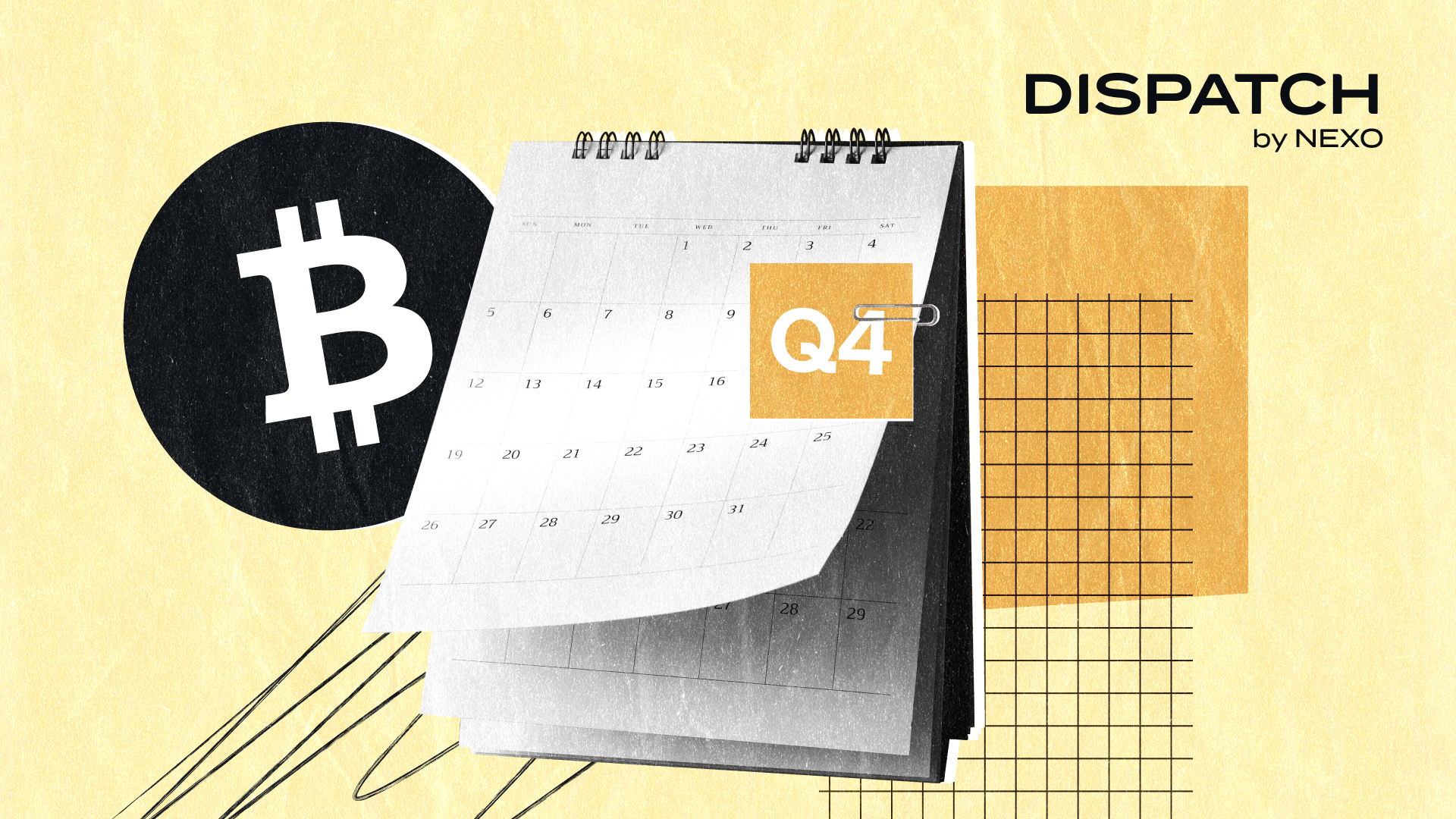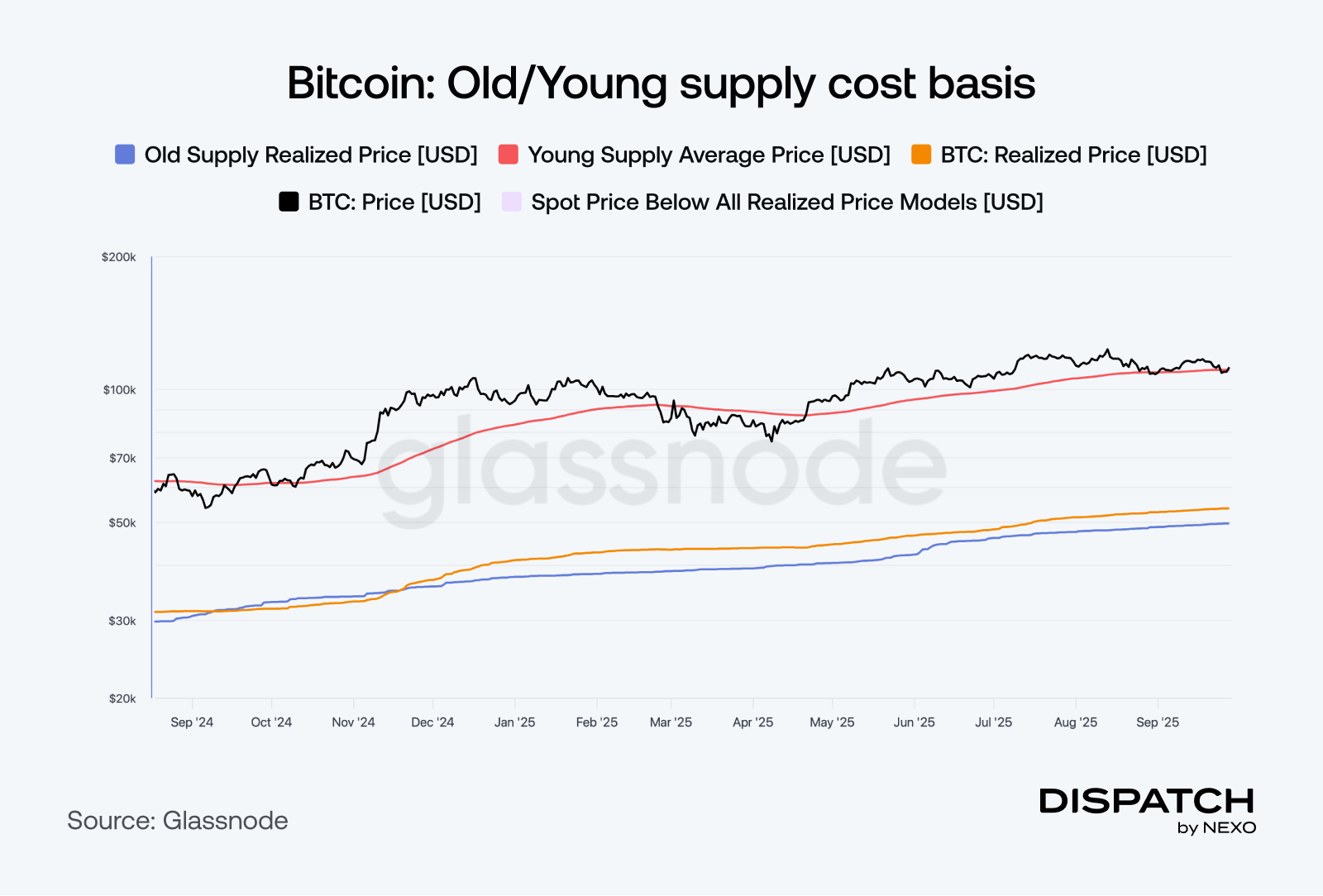Dispatch #264: Will Q4 revive Bitcoin’s rally?
Sep 30•6 min read

In this patch of your weekly Dispatch:
- A new stablecoin projection
- Solana’s latest foray
- Another week of labor (reports)
Market cast
BTC: Neutral signals in a tight range
On the weekly chart, Bitcoin looks range-bound after a brief correction and rebound from the middle Bollinger Band, a classic gauge of volatility and trend. The ADX is fading, confirming weak directional strength. Both RSI and the Stochastic Oscillator remain neutral, while the MACD sits below zero, offering little conviction.
The daily chart tells the same story. Price is pressing against the middle Bollinger Band, but most signals point to choppy trade. RSI and Stochastic stay neutral, while the MACD hovers near zero — a bullish trigger would require a moving-average crossover. With ADX readings extremely low, the setup underscores just how little trend momentum the market currently has, with support seen around $112,000–$110,000 and resistance capped near $115,000–$117,000.
The big idea
Can Bitcoin regain momentum in Q4?
Last week in Dispatch we unpacked the forces driving Bitcoin. But the world’s leading crypto asset came under pressure, briefly sinking below $110,000. This week, we return to the question: what could push Bitcoin higher in the months ahead? History says Q4 tends to be favorable, but the path forward will be shaped by a mix of macro, flows, resilience, and scarcity.
Macroeconomic crosscurrents
This week’s U.S. labor data takes on outsized importance: softer prints would strengthen the case for Fed rate cuts — a liquidity shift that risk assets, including crypto, are quick to price in. Resilient data, on the other hand, could keep the Fed in “higher for longer” mode, limiting upside. Beyond jobs, the Q4 calendar is heavy: GDP releases on Oct. 30, Nov. 26, and Dec. 19, Core PCE at each month-end, and CPI mid-month. Add in the Fed’s Oct. 28–29 and Dec. 9–10 meetings, and Bitcoin faces a macro gauntlet where every print can tilt liquidity expectations.
Wall Street’s holiday shopping list: more Bitcoin
Heading into Q4, institutional demand continues to set the pace. Spot Bitcoin ETFs have now pulled in $21.5 billion in net inflows year-to-date, with only February, March, and August showing outflows. That’s an average of $2.4 billion per month, nearly double Bitcoin’s fresh issuance of around 450 BTC monthly, or $1.35 billion at $100,000. If this pace persists, it sets the stage for a textbook supply crunch, where Wall Street’s steady bid absorbs more than miners can produce, tilting the balance firmly toward demand.
Bitcoin’s price resilience under fire
September dealt Bitcoin its sharpest wobble since spring, with prices sliding nearly $3,700 in just five days. That move temporarily lifted the share of supply in loss from 6% to 11% and doubled UTXOs in loss from 2.7% to 5.4%. Net Unrealized Profit/Loss (NUPL) contracted from 0.54 to 0.52, trimming paper gains but stopping well short of capitulation.
Volumes spiked into the decline before fading quickly — a stark contrast to March’s steep drop to $70,000, when loss-bearing supply ballooned to 26% and selling pressure became self-reinforcing. This time, the market bent but didn’t break.
The lesson: at six-figure levels, even modest pullbacks now expand loss-bearing supply, yet the market has so far treated them as turbulence rather than crisis. Bitcoin’s higher base is being stress-tested — and, for now, the structure is holding.
From BTC abundance to BTC scarcity
With 95% of Bitcoin’s supply soon in circulation, what matters now is liquidity. Long-term holders and large entities controlling 1,000+ BTC are on track to lock up over six million coins by year-end, nearly a third of all that will ever exist.
This tightening float has already powered fresh highs and raises the stakes: scarcity supports the long-term case, but concentrated selling could still rattle markets. For investors, the real question isn’t whether to hold Bitcoin, but how. Fixed-term yield strategies, like those on Nexo, turn scarcity into both appreciation and income.
Hot in crypto
Solana steps up
Solana has grabbed the spotlight this week on both the ETF and infrastructure fronts. According to Bloomberg’s James Seyffart, a wave of amended filings from Fidelity, Franklin Templeton, CoinShares, Bitwise, Grayscale, Canary Capital, and VanEck suggests spot Solana ETFs with staking could hit the market within weeks. Fidelity even disclosed plans to stake its SOL holdings for yield — a notable move as issuers and the SEC appear to be ironing out details. Seyffart noted the updates show “signs of movement” and could pave the way for approval as early as mid-October.
On the tech side, Jump Crypto’s Firedancer team has proposed removing Solana’s per-block compute unit limit after the Alpenglow upgrade, which already promises to slash block finality from 12.8 seconds to just 150 milliseconds. The plan could create a performance flywheel by incentivizing validators to upgrade hardware, though some warn of centralization risks. Together, the ETF momentum and structural upgrades underline Solana’s drive to entrench itself as both an institutional product and a high-performance chain.
TradFi trends
Stablecoins scale into the trillions
The stablecoin market has smashed past $300 billion in supply this year, led by USDT’s $173 billion dominance and USDC’s surge following its IPO. Daily wallet-to-wallet transfers in Tether alone now top $17 billion, underscoring how deeply stablecoins have embedded themselves into global payments.
Citi added fuel to the optimism, lifting its 2030 forecast to $1.9 trillion (bull case: $4 trillion), citing regulatory clarity from the GENIUS Act and accelerating adoption. With transaction volumes already near $1 trillion per month, Citi sees deposit substitution, crypto market growth, and even banknote replacement driving the next leg higher.
Macroeconomic roundup
Will the labor market lead the way to lower rates?
This week’s U.S. labor data takes on outsized importance: softer prints would strengthen the case for Fed rate cuts — a liquidity shift that risk assets, including crypto, are quick to price in.
JOLTS (Tue): Forecast at 7.1 million openings, down from July’s 7.2 million. Another decline would underline cooling demand and boost rate-cut bets.
ADP Employment (Wed): Expected at +40,000, down from +54,000 in August. Weak hiring supports a softer Fed stance but risks stoking recession fears.
Initial Jobless Claims (Thu): Seen at 228,000 vs. 218,000 prior. Higher claims would add to dovish pressure, while steady prints keep the focus on inflation.
Nonfarm Payrolls & Unemployment (Fri): Payrolls seen at +45,000 vs. +22,000 last month, with unemployment steady at 4.3%. Modest gains with slack in the market would be viewed as liquidity-friendly for risk assets.
The week’s most interesting data story
Old vs new BTC holders
Bitcoin’s price action reflects a tug-of-war between old and new holders. Long-term holders — those who accumulated years ago — decide how much supply remains locked away, effectively setting the floor by limiting liquidity. Meanwhile, short-term holders, with coins acquired in the past six months, often determine when profits are realized. Their cost basis, currently clustered near $110,775, has repeatedly acted as a pivot in recent months. In this way, Bitcoin’s levels are shaped both by the conviction of old holders and the willingness of new entrants to take profit.

The numbers
The week’s most interesting numbers
- 640,031 BTC — Strategy’s stash, worth $71.8 billion.
- $46 billion — Stablecoin net inflows over the past 90 days.
- 71.8 million SOL — Solana’s ATH futures open interest worth $14.5 billion.
- $300,000 — Analysts’ projected range for Bitcoin’s bull market, with upside potential fueled by gold correlation.
- 90%+ — CME FedWatch odds of a 25 bps Fed rate cut at the next October meeting.
Hot topics
What the community is discussing
The evolution of the world’s leading digital asset.
Is that a dip on the charts?
How cool is that Nexo chip!
Dispatch is a weekly publication by Nexo, designed to help you navigate and take action in the evolving world of digital assets. To share your Dispatch suggestions and comments, email us at [email protected].
